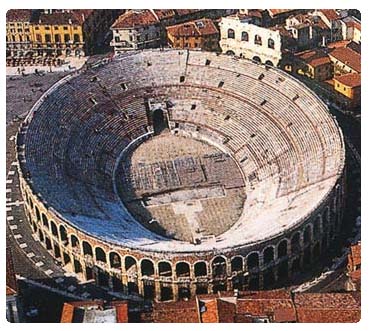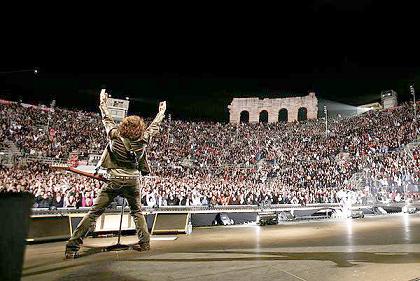Please please please, place it back exactly as you found it, otherwise the spoiler will not work and we Could have problems in the maintenance of the cache itself. Pay attention when you grab it to be' sure to place it back again where it was. Thank you for your cooperation.
. . . . . . . . . . . . . . . . . . . . . . . . . . . . . . . . . . . . . . . . . . . . .
L'Arena di Verona is clearly the Symbol of Verona. Some caches have been placed before around here (one of them was our first catch), but all dissapeared. Well... we decided to try again. Please use stealth!!!!

ITALIANO
L'Arena, l'anfiteatro romano, è senza dubbio il monumento cittadino più rappresentativo e conosciuto di Verona.
Fu costruito alla fine del I secolo dopo Cristo per ospitare i combattimenti di gladiatori tanto in voga nell'antica Roma, si innalzava imponente dal grande spazio rimasto fuori dalle mura che chiudevano l'ansa dell'Adige verso sud. Le sue dimensioni ci dimostrano lo sviluppo e l'importanza che Verona doveva avere avuto nei decenni dell'epoca imperiale. L'Arena, con una capienza di circa 20.000 spettatori è infatti il terzo anfiteatro romano per grandezza dopo il Colosseo di Roma e l'Arena di Capua.
L'anfiteatro di Verona tuttavia è così ben conservato da essere tutt'ora utilizzato per concerti, musica, ma soprattutto per la stagione operistica per ammirare la quale vengono a Verona visitatori da tutto il mondo. Grazie alle sue particolarità costruttive, l'acustica dell'Arena è tale che durante i concerti operistici non viene utilizzata alcuna amplificazione ne' per la musica ne' per la voce.

>ENGLISH
The building itself was built in AD 30 on a site which was then beyond the city walls. The ludi (shows and games) staged there were so famous that spectators came from many other places, often far away, to witness them. The amphitheatre could host more than 30,000 spectators in ancient times. The round façade of the building was originally composed of white and pink limestone from Valpollicella, but after a major earthquake in 1117, which almost completely destroyed the structure's outer ring, except for the so-called "ala", the stone was quarried for re-use in other buildings. Nevertheless it impressed medieval visitors to the city, one of whom considered it to have been a Labyrinth, without ingress or egress. Ciriaco d?anconawas filled with admiration for the way it had been built and Giovanni Antonio Panteo's civic panegyric De laudibus veronae, 1483, remarked that it struck the viewer as a construction that was more than human. The first interventions to recover the arena's function as a theatre began during the Renaissance. Some operatic performances were later mounted in the building during the 1850s, owing to its outstanding acoustics. And in 1913, operatic performances in the arena commenced in earnest due to the zeal and initiative of the Italian opera tenor Zenatello and the impresario Ottone Rovato. The first 20th-century operatic production at the arena, a staging of Giuseppe Verdi's Aida, took place on 10 August of that year, to mark the birth of Verdi 100 years before in 1813. Musical luminaries such as Puccini and Mascagni were in attendance. Since then, summer seasons of opera have been mounted continually at the arena, except in 1915–18 and 1940–45, when Europe was convulsed in war. Nowadays, four productions are mounted each year between June and August. During the winter months, the local opera and ballet companies perform at the L'Accademia Filarmonica. Modern-day travellers are advised that admission tickets to sit on the arena's stone steps are much cheaper to buy than tickets giving access to the padded chairs available on lower levels. Candles are distributed to the audience and lit after sunset around the arena. Every year over 500,000 people see productions of the popular operas in this arena. Once capable of housing 20,000 patrons per performance (now limited to 15,000 because of safety reasons), the arena has featured many of world's most notable opera singers. In the post-World War II era, they have included Giuseppe Di Stefano, Maria Callas, Tito Gobbi and Renata Tebaldi among other names. A number of conductors have appeared there, too. The official arena shop has historical recordings made by some of them available for sale.The opera productions in the Verona Arena had not used any microphones or loudspeakers until an electronic sound reinforcement system was installed in 2011. In recent times, the arena has also hosted several concerts of international rock and pop bands, among which Pink Floyd, Simple Minds, Duran Duran, Deep Purple, The Who, Dire Straits, Mike Oldfield, Rod Stewart, Sting, Pearl Jam, Radiohead, Muse

>DEUTSCH
Das Theater wurde etwa im Jahr 30 n. Chr. errichtet und lag damals außerhalb der römischen Stadtmauer Veronas. In römischer Zeit fasste die Arena über 30.000 Zuschauer und wurde für Gladiatorenkämpfe und Wettkämpfe genutzt. Die Außenfassade war mit weißem und rosa Kalkstein verkleidet. Nach einem Erdbeben im Jahr 1117, bei dem der größte Teil des Außenrings zerstört wurde, diente die Arena als Steinbruch für die wachsende mittelalterliche Stadt. Heute sind nur noch vier Bögen des ehemals die Arena vollständig umfassenden Außenrings erhalten. Sie werden von den Veronesern „l'ala“ – der Flügel – genannt. Im Jahr 1278 war die Arena der Schauplatz der letzten großen Katharer-Hinrichtung: Nach den Erfolgen der Inquisition in den 1250er Jahren in Südfrankreich in deren Kampf gegen die Katharer zogen sich die Überlebenden nach Norditalien zurück. Sie konnten die Festung Sirmione als letzte Zufluchtsstätte halten. 1276 wurde die Burg jedoch eingenommen und die Katharer, die die Eroberung überlebt hatten, wurden im Jahr 1278 in der Arena von Verona verbrannt. In der Renaissance gab es Bestrebungen, das Bauwerk wieder als Theater zu nutzen. Dies geschieht aber erst seit 1913 wieder regelmäßig. Am 10. August 1913 wurde anlässlich des 100. Geburtstags von Giuseppe Verdi die Oper Aida aufgeführt. Aufgrund der hervorragenden Akustik konnte sich die Arena schnell als Konzertstätte etablieren. Heute finden vor allem in den Monaten Juni, Juli und August Opernaufführungen und Rock-Konzerte statt.
Thanks to wikipedia